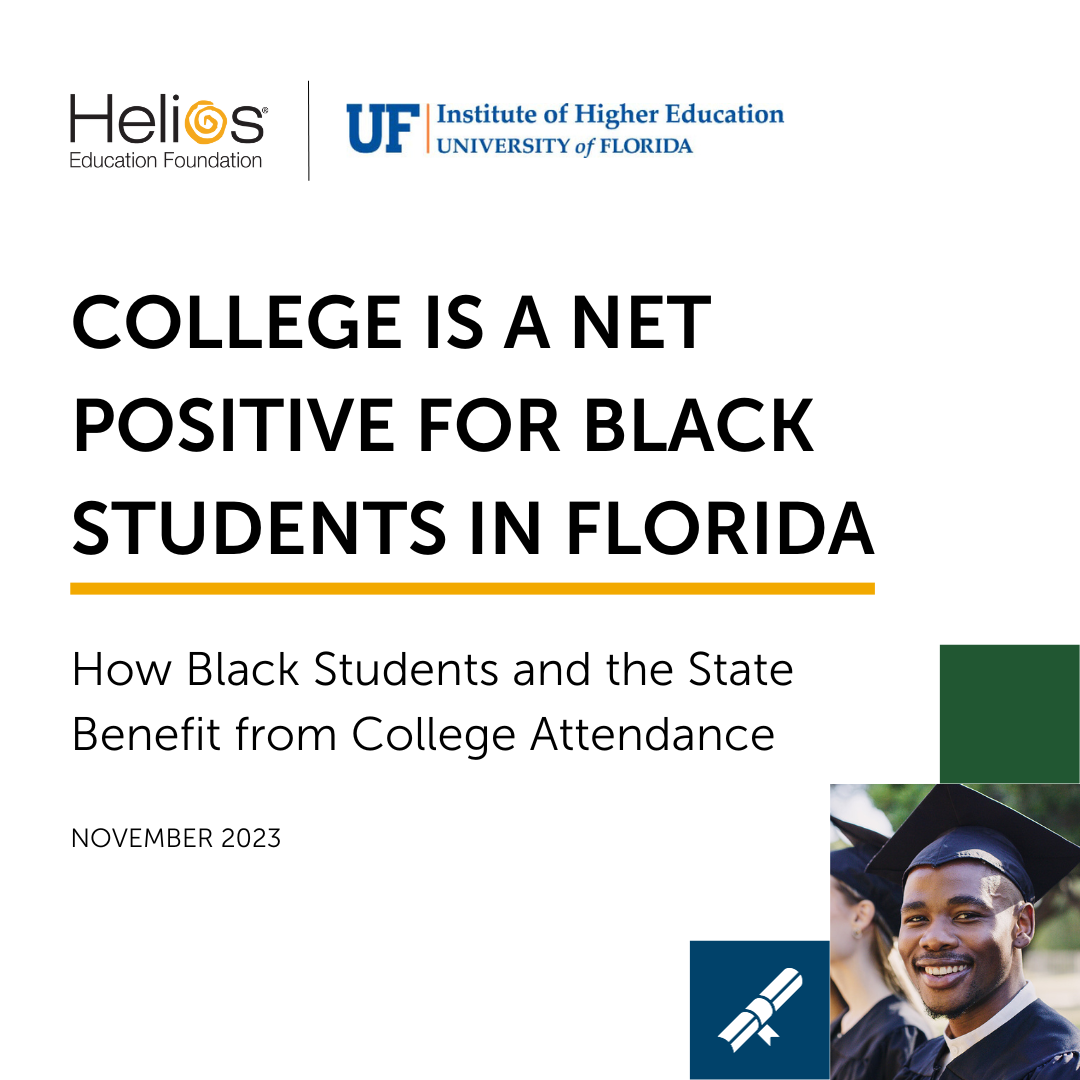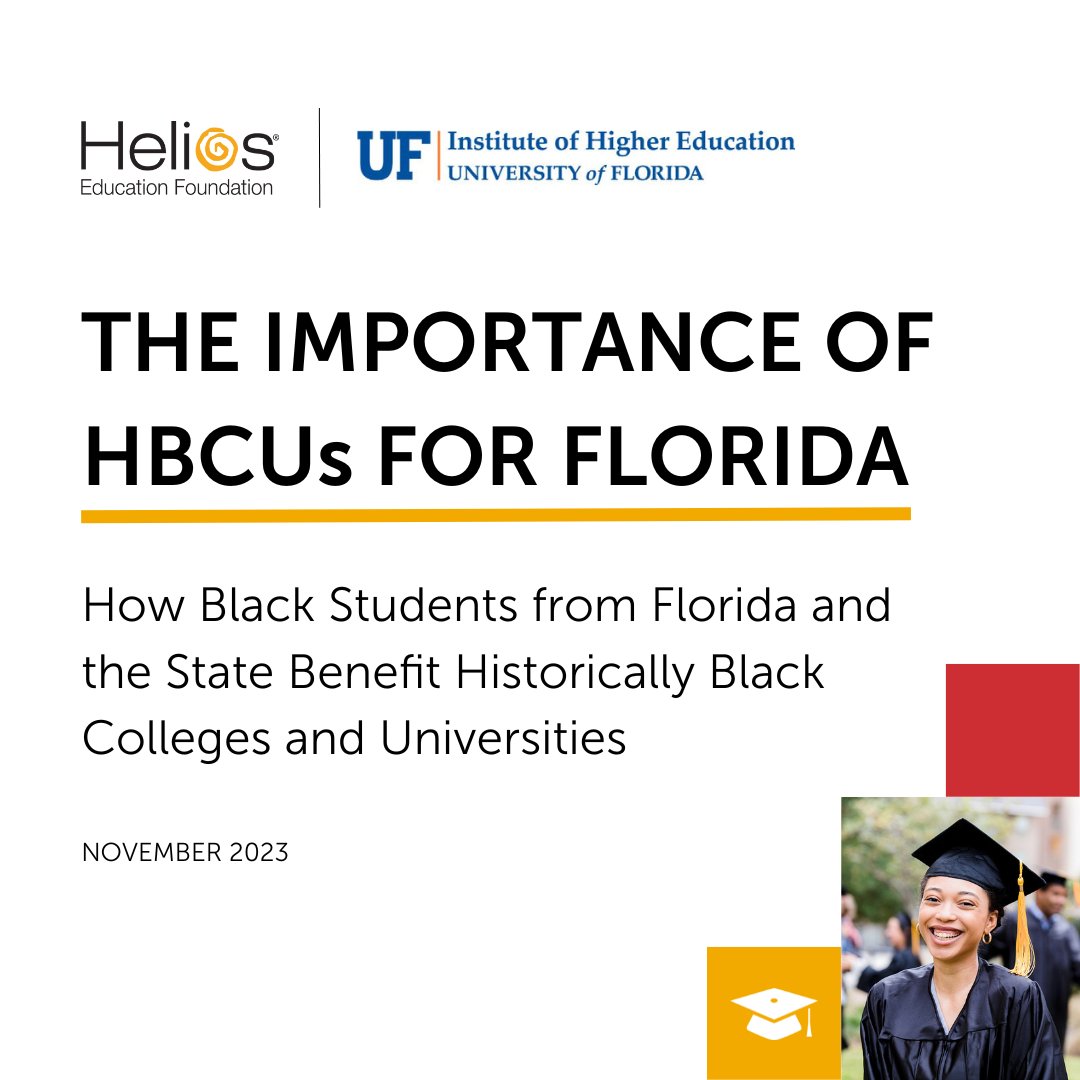College enrollment drives greater outcomes for Black Florida students and Florida
There is a robust amount of research that shows college is worth it. However, there is comparatively little research focused on the value of college for Black students. Helios Education Foundation and the Institute of Higher Education at the University of Florida released a two-part research study that seeks to better understand the advantages to college enrollment for Black students in Florida, how the state can benefit as a result, and the role of Florida’s Historically Black Colleges and Universities (HBCUs) in educating Black students.
The first research brief, College is a Net Positive for Black Students in Florida, examines 96,710 Black Florida high school students who took the SAT between 2004 and 2010. The findings show clear and compelling advantages associated with college attendance that not only benefit Black students, but the state of Florida as well. From the research we saw that enrolling initially at a four-year institution is the most viable pathway for Black students to earn a bachelor’s degree. Doing so leads to a 42.9 percentage point increase in the probability of earning a bachelor’s degree when compared to students who did not initially enroll in college, and an approximate 30 percentage point increase when compared to students who initially enrolled in a two-year college.
The research also shows that college is a long-term investment that turns from negative to positive around 20 years after college. For Black students who initially enroll in a four-year college or university, they are expected to see a $130,000 positive net present value after 35 years from initial college enrollment. In other words, the research shows college is worth the investment.
Net present value is a measure that captures the total value for a student investing in going to college. Net present value is the discounted sum of streams of estimated income in years not enrolled in college less net tuition for each year enrolled in college. A positive net present value means that students will likely benefit financially from investing in going to college.
The second research brief, The Importance of HBCUs for Florida, examines Black Florida student enrollment at HBCUs. The study revealed that HBCUs are associated with an increase in likelihood that a Black student will complete college and earn a degree.
Among the 96,710 Black high school students who took the SAT and graduated from a high school in Florida between 2004 and 2010, approximately 35% (35,380 individuals) sent an application to at least one HBCU in the U.S. Of these applicants, 40% initially enrolled at an HBCU.
The research shows Black students attending HBCUs have a 40% increase in probability of earning a bachelor’s degree. Additionally, Florida’s four HBCUs, including Bethune-Cookman University, Edward Waters University, Florida Agricultural and Mechanical University, and Florida Memorial University, graduate more Black students in STEM disciplines than all other Florida universities combined.
Furthermore, the research revealed that Black Florida students who enroll at HBCUs can expect to see a $60,000 positive net present value after 35 years from initial college enrollment.
The findings from the research briefs suggests increasing college enrollment rates among Black high school graduates in Florida has the potential to generate upward shifts in degree completion rates, increased earnings over time, and increased likelihood of in-state students remaining in state. The findings also show that HBCU enrollment has significant beneficial impacts for Black students and for Florida, including higher degree completion rates, higher annual earnings, and corollary social and economic benefits.
About the research
Our core research questions centered on the impact of college enrollment among Black students in Florida including:
- How does initially enrolling in a community college or four-year institution impact Florida’s Black high school students’ postsecondary, economic and financial success?
- How is the state of Florida impacted by its Black high school graduates initially enrolling in a community college or four-year institution?
- How does initially enrolling in an HBCU impact Florida’s Black high school students’ postsecondary, economic and financial success?
- How is the state of Florida impacted by its Black high school students initially enrolling in an HBCU?
This project used one of the largest student-level datasets in the U.S., following Black students throughout the state of Florida from high school, through college, and tracking their financial outcomes in November 2017, around age 30.
The breadth and depth of the data allowed us to use rigorous methods and consider a wide range of impacts related to initial HBCU enrollment. The base data consist of all Black high school students in the state of Florida who took the SAT between 2004 and 2010. These data included test scores, high schools enrolled, basic demographics (including parental income and education), and the individual colleges to which students sent their SAT score, which represents a validated proxy for college applications.
To create the analytic dataset, we merged SAT data with National Student Clearinghouse data, which contain information about college enrollment spells, any degrees earned, and the types of degrees earned.
The final step to create the analytic dataset included merging credit bureau data, which has hundreds of financial variables for the students in a November 2017 snapshot, when the former students are around age 30, including an estimated household income, credit score, student loan balance and repayment, default, credit card debt, mortgages, and zip code of residence.

